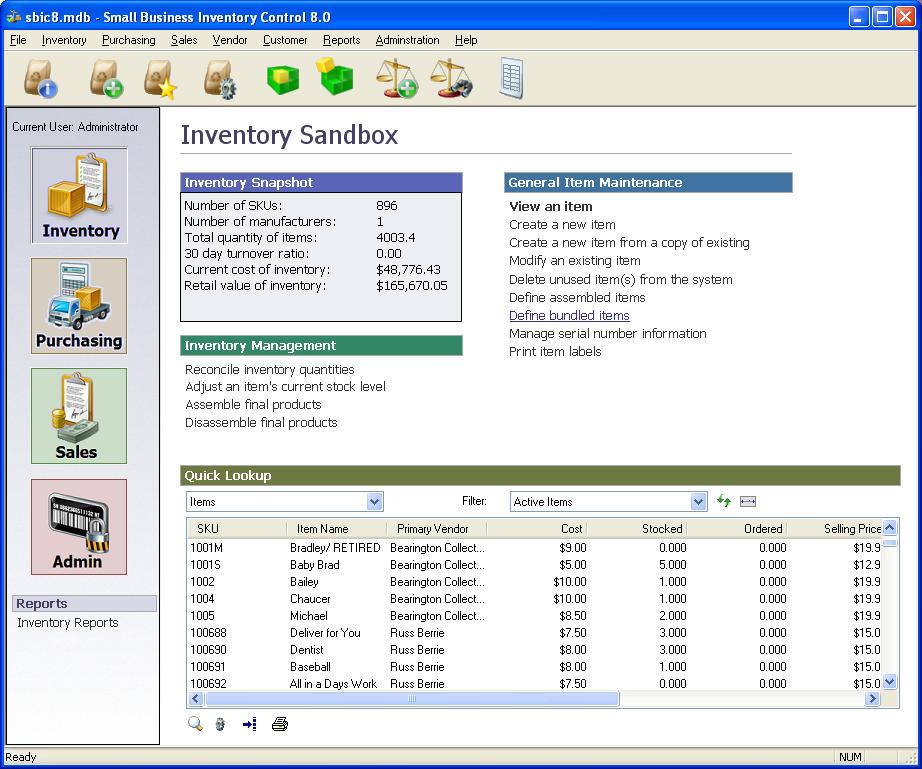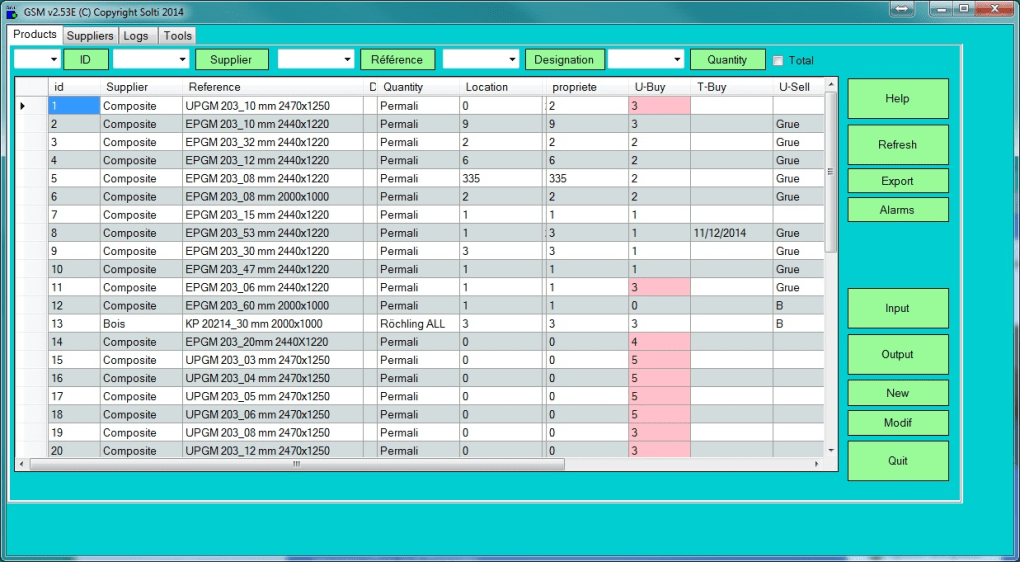Delve into the world of simple small business inventory software, where businesses of all sizes can harness the power of technology to streamline their operations, reduce costs, and enhance customer satisfaction. From cloud-based solutions to mobile-friendly apps, this guide will explore the essential features, benefits, and best practices of inventory software, empowering you to make informed decisions that will drive your business towards success.
Overview of Simple Small Business Inventory Software
Inventory management is crucial for small businesses to maintain accurate records of their stock, optimize operations, and make informed decisions. Simple inventory software provides an efficient and cost-effective solution to these challenges.
Simple inventory software empowers small businesses to track inventory levels, manage orders, and generate reports. These solutions typically offer key features such as product cataloging, barcode scanning, stock level monitoring, purchase order management, and reporting capabilities.
Use Cases
Simple inventory software finds applications across various industries, including retail, manufacturing, distribution, and hospitality. For instance, in retail, it helps manage inventory across multiple stores, track sales, and optimize stock levels. In manufacturing, it enables businesses to monitor raw materials, work-in-progress, and finished goods inventory.
Types of Simple Small Business Inventory Software
Small businesses have a range of inventory software options to choose from, each with its own advantages and disadvantages. Understanding the different types of software can help businesses select the best solution for their needs and budget.
Cloud-Based Inventory Software
- Advantages:
- Accessible from anywhere with an internet connection
- Automatic updates and backups
- Often more affordable than desktop-based software
- Disadvantages:
- Requires a stable internet connection
- May have limited functionality compared to desktop-based software
Desktop-Based Inventory Software
- Advantages:
- Installed on a local computer, providing more control and security
- Typically more powerful and feature-rich than cloud-based software
- No internet connection required
- Disadvantages:
- Not accessible remotely
- Requires manual updates and backups
- Can be more expensive than cloud-based software
Mobile-Based Inventory Software
- Advantages:
- Allows for inventory management on the go
- Convenient for businesses with remote or mobile employees
- Can be integrated with other business apps
- Disadvantages:
- May have limited functionality compared to desktop-based software
- Can be more expensive than cloud-based software
- Requires a reliable internet connection
Selecting the Right Type of Software
The best type of inventory software for a small business depends on its specific needs and budget. Businesses should consider the following factors:
- Size of the business: Larger businesses may need more powerful and feature-rich software than smaller businesses.
- Industry: Some industries, such as retail, may have specific inventory management requirements.
- Budget: Cloud-based software is often more affordable than desktop-based software, but it may have limited functionality.
- IT resources: Businesses with limited IT resources may prefer cloud-based software that requires less maintenance.
Features to Consider When Choosing Simple Inventory Software

When selecting inventory software for your small business, it’s crucial to consider essential features that enhance inventory management efficiency and accuracy. These include:
Inventory Tracking
Effective inventory tracking allows you to monitor stock levels in real-time. This enables you to identify discrepancies, prevent overstocking, and avoid stockouts.
Order Management
Integrated order management capabilities streamline the order fulfillment process. You can track orders from placement to delivery, ensuring timely and accurate fulfillment.
Reporting
Robust reporting functionality provides valuable insights into inventory performance. Generate reports on stock levels, sales trends, and reorder points to make informed decisions.
Integrations with Other Business Systems
Compatibility with your existing business systems, such as accounting or e-commerce platforms, ensures seamless data exchange and eliminates manual data entry errors.
Benefits of Using Simple Small Business Inventory Software

Inventory software can provide numerous benefits to small businesses, helping them save time, reduce costs, and improve overall efficiency. Here are some key advantages of using simple inventory software:
Improved Inventory Accuracy
- Eliminates manual errors and discrepancies in inventory tracking.
- Provides real-time visibility into inventory levels, ensuring accurate stock counts.
- Reduces the risk of overstocking or understocking, leading to optimized inventory management.
Reduced Waste
- Prevents spoilage and damage by tracking inventory expiration dates and FIFO (First-In, First-Out) principles.
- Minimizes excess inventory and reduces the need for costly write-offs.
- Helps businesses identify slow-moving items and adjust purchasing strategies accordingly.
Enhanced Customer Satisfaction
- Ensures availability of products, reducing the likelihood of stockouts and customer dissatisfaction.
- Facilitates faster and more accurate order fulfillment, improving customer experience.
- Provides data for demand forecasting, enabling businesses to anticipate customer needs and maintain optimal inventory levels.
Case Studies and Testimonials, Simple small business inventory software
Small businesses have reported significant benefits after implementing simple inventory software solutions. For instance, a hardware store experienced a 15% reduction in inventory shrinkage and a 20% increase in sales accuracy. Another small business, a clothing boutique, saw a 30% improvement in customer satisfaction due to reduced stockouts and faster order processing.
Implementation and Best Practices for Simple Inventory Software
Implementing inventory software in a small business can streamline operations and improve efficiency. Follow these steps for a successful implementation:
- Choose the right software: Select a software that meets your specific business needs and budget.
- Data entry: Enter all inventory items, including quantities, descriptions, and locations.
- Set up alerts: Configure alerts for low stock levels and other important events.
- Train staff: Ensure all staff members are trained on using the software effectively.
- Monitor and adjust: Regularly review inventory levels and make adjustments to optimize stock levels.
Best Practices for Inventory Management
Implement these best practices to enhance inventory management:
- Regular inventory counts: Conduct regular physical inventory counts to ensure accuracy.
- Cycle counting: Perform periodic counts of a portion of inventory to identify discrepancies.
- Inventory optimization techniques: Use techniques like ABC analysis and reorder point calculations to optimize stock levels.
Training and Data Accuracy
To ensure data accuracy and effective software usage:
- Train staff: Provide comprehensive training to all staff responsible for inventory management.
- Establish clear guidelines: Define clear guidelines for data entry and inventory handling.
- Regular audits: Conduct regular audits to verify data accuracy and adherence to guidelines.
Trends and Future of Simple Small Business Inventory Software

The future of simple small business inventory software is bright, with emerging trends such as artificial intelligence (AI) and machine learning (ML) playing a significant role in optimizing and forecasting inventory.
AI and ML algorithms can analyze historical data, identify patterns, and make predictions, enabling businesses to optimize their inventory levels, reduce waste, and improve efficiency. These technologies can also provide real-time insights into inventory performance, allowing businesses to make informed decisions quickly.
Role of AI and ML in Inventory Optimization and Forecasting
AI and ML algorithms can be used to:
- Analyze historical sales data to identify trends and patterns.
- Predict future demand based on historical data and external factors.
- Optimize inventory levels to minimize waste and maximize efficiency.
- Generate automatic reordering recommendations based on forecasted demand.
By leveraging AI and ML, businesses can gain a competitive advantage by improving their inventory management practices and reducing costs.
Future of Inventory Software
The future of inventory software for small businesses will continue to evolve to meet the changing needs of businesses.
- Cloud-based software: Cloud-based inventory software will become increasingly popular, providing businesses with the flexibility and scalability they need to manage their inventory from anywhere.
- Mobile applications: Mobile inventory apps will become more sophisticated, allowing businesses to manage their inventory on the go.
- Integration with other business systems: Inventory software will continue to integrate with other business systems, such as accounting and CRM software, to provide businesses with a complete view of their operations.
By staying up-to-date with the latest trends and advancements in inventory software, small businesses can improve their efficiency, reduce costs, and gain a competitive advantage.
Epilogue: Simple Small Business Inventory Software
In the ever-evolving landscape of small business management, simple inventory software stands as a beacon of efficiency and profitability. By embracing the transformative power of these solutions, businesses can unlock a wealth of benefits that will propel them towards sustained growth and prosperity. The future of inventory management is bright, with artificial intelligence and machine learning poised to revolutionize the way businesses track, manage, and optimize their inventory. As technology continues to advance, small businesses will have access to even more powerful tools to streamline their operations and achieve their entrepreneurial dreams.
Common Queries
What are the key benefits of using simple small business inventory software?
Simple small business inventory software offers a myriad of benefits, including improved inventory accuracy, reduced waste, enhanced customer satisfaction, time savings, and cost reduction.
How do I choose the right type of inventory software for my business?
Consider your business needs, budget, and the specific features you require. Cloud-based solutions offer flexibility and accessibility, while desktop-based software provides more control and customization. Mobile-based apps offer convenience and real-time updates.
What are some best practices for implementing and using inventory software?
Start by defining your inventory management goals, train staff thoroughly, establish regular inventory counts and cycle counting procedures, and leverage reporting features to identify trends and optimize inventory levels.